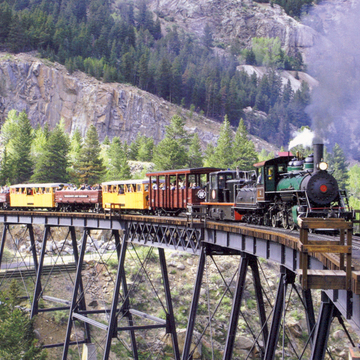This is the railroad that moved a highway. I70 was blasted out of a mountain-side instead of ripping up the Clear Creek Valley in order to protect the ruins of the engineering marvel. Two miles—and a rise of 638 feet—separated Georgetown and Silver Plume. Robert Blickensderfer, a Union Pacific engineer, designed the original 4.47 miles of track, which used two hairpin turns and looped over itself to cut a 6 percent grade to 3.5 percent. At the Devil's Gate Viaduct, a 300-foot bridge spanned the track and Clear Creek 95 feet below. Sightseers from all over the globe came to gawk, if not to “do the loop” on “that famous knot in a railroad.” Mining and tourism had both played out in 1939 when the Colorado and Southern Railway, last operator of the Georgetown Loop, abandoned the line, scrapping the Devil's Gate Viaduct for $450.
The resurrected train stops at the Lebanon Mine (1870s) for an underground mine tour. The site includes the 1970s restorations of the 1870s Lebanon Mill, the office of mine manager Julius Pohle, a change room, and a blacksmith shop. The Pohle-Toll House (1878) resembles Gothic Revival designs that Andrew Jackson Downing published in several editions of his Cottage Residences beginning in 1842. It has narrow windows, pendant ornaments for windows and gables, and overhanging eaves.





